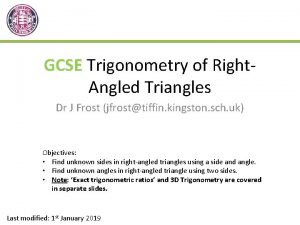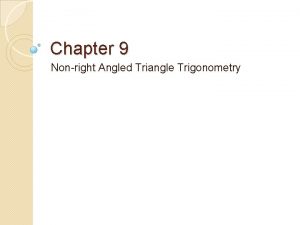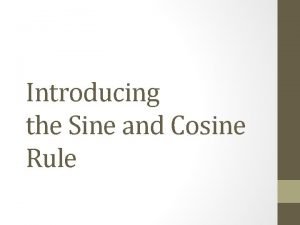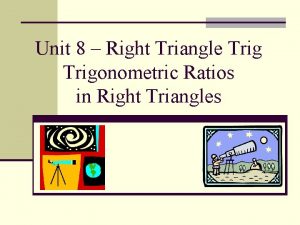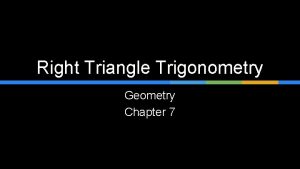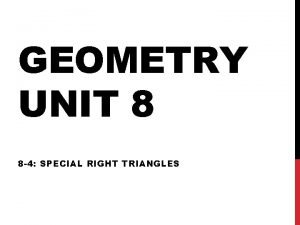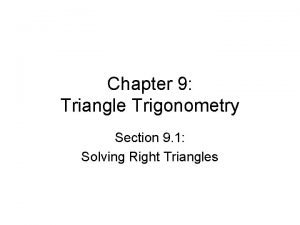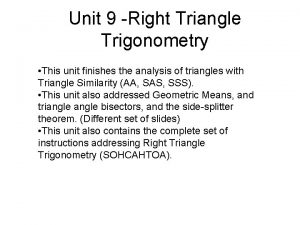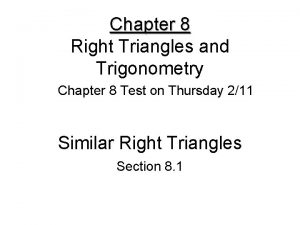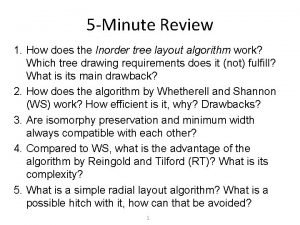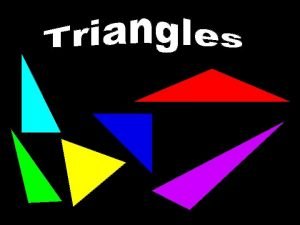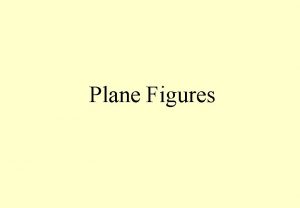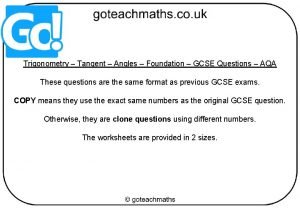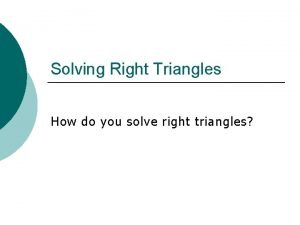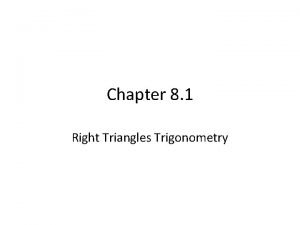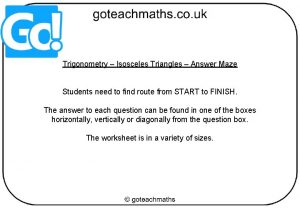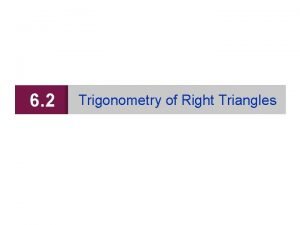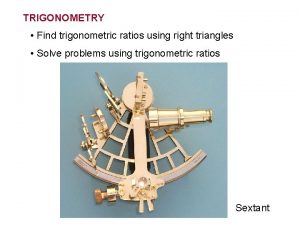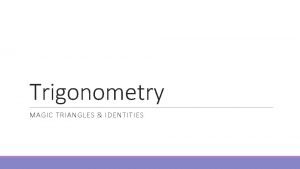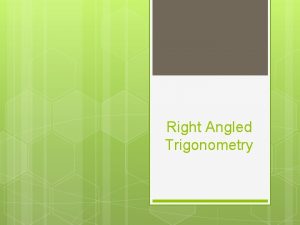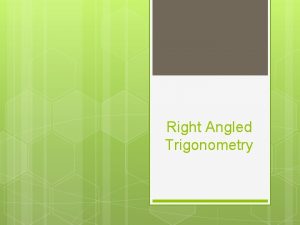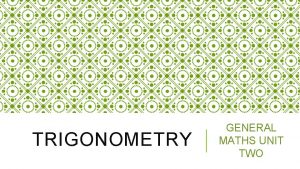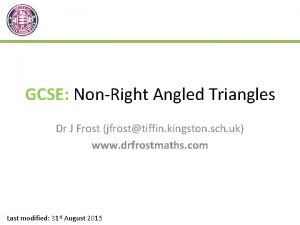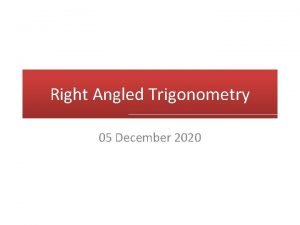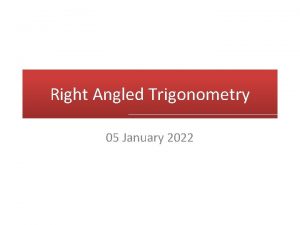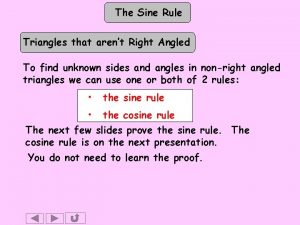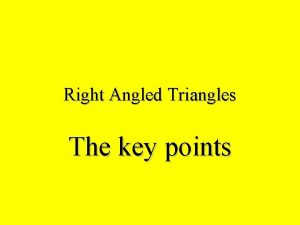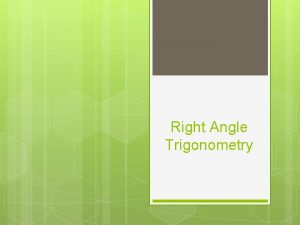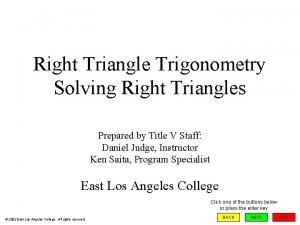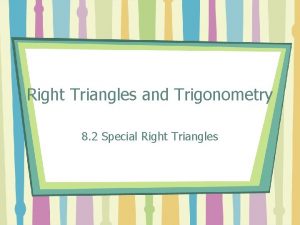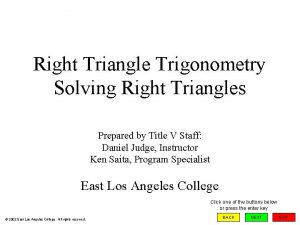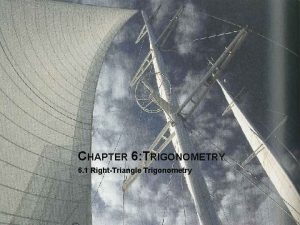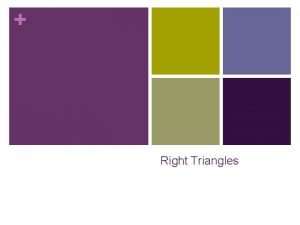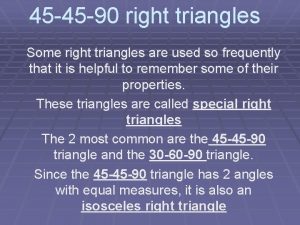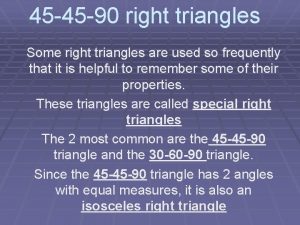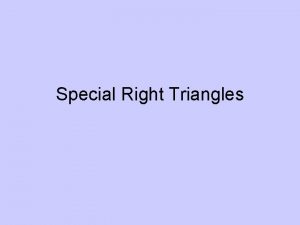GCSE Trigonometry of Right Angled Triangles Dr J






















![Test Your Understanding [Edexcel IGCSE Jan 2014(R)-3 H Q 17] The diagram shows triangle Test Your Understanding [Edexcel IGCSE Jan 2014(R)-3 H Q 17] The diagram shows triangle](https://slidetodoc.com/presentation_image_h/a5fb370d7ee4fdbb4c5d0a24d49ec28c/image-23.jpg)



- Slides: 26

GCSE Trigonometry of Right. Angled Triangles Dr J Frost (jfrost@tiffin. kingston. sch. uk) Objectives: • Find unknown sides in right-angled triangles using a side and angle. • Find unknown angles in right-angled triangle using two sides. • Note: ‘Exact trigonometric ratios’ and 3 D Trigonometry are covered in separate slides. Last modified: 1 st January 2019

www. drfrostmaths. com Everything is completely free. Why not register? Register now to interactively practise questions on this topic, including past paper questions and extension questions (including UKMT). Teachers: you can create student accounts (or students can register themselves), to set work, monitor progress and even create worksheets. With questions by: Dashboard with points, trophies, notifications and student progress. Teaching videos with topic tests to check understanding. Questions organised by topic, difficulty and past paper.

Motivation I was in Year 9 and was trying to write a computer program that would draw an analogue clock (as you do). I needed to work out the two coordinates to draw the minute hand between, and similarly for the hour hand, given the current hour, minute and desired length of each hand. I couldn’t work out how to do it, until I (coincidentally) learnt trigonometry in maths the next day, and was able to finish my program that evening!

Starter 13 3 5 4 ? ?

But… We used Pythagoras’ theorem if all 3 sides of a right-angled triangle were involved. But what if we had two sides involved an angle? (excluding the right-angle) Unknown angle. Unknown side.

Names of sides relative to an angle The hypotenuse is the longest side of a rightangled triangle, and is opposite the right-angle. opposite ? The ‘opposite’ is the side opposite the angle of interest. ? hypotenuse 30° adjacent ? The ‘adjacent’ is the side adjacent (i. e. next to) the angle of interest.

Quickfire Side Naming Hypotenuse Opposite Adjacent 60° 1 2 ? ? 1? ? 2 ? ? ? 20°

Sin/Cos/Tan ! sin, cos and tan are functions which take an angle and give us the ratio between pairs of sides in a right angle triangle. Recall that ratio can just mean how many times bigger one quantity is than another. ? ? You can remember this using: “soh cah toa” ?

Examples Step 1: Determine which sides are hyp/adj/opp. Step 2: Work out which trigonometric function we need. Step 3: Rearrange the equation to find the unknown.

Further Example ?

Test Your Understanding So Far ?

Harder Examples 60 ° ? 12 ? 30° 4

Test Your Understanding 1 2 ? 8. 63 ? 20. 2

Exercise 1 1 (questions on provided sheet) a ? b 15 22 c 4 e ? ? f ? 10 20 g ? d ? 3 Q 2 -7 on next slide…

Exercise 1 2 (questions on provided sheet) 5 ? ? 3 6 ? 4 [Edexcel GCSE June 2012 -2 H Q 18] The diagram shows a quadrilateral ABCD. AB = 16 cm. AD = 12 cm. Angle BCD = 40°. Angle ADB = angle CBD = 90°. Calculate the length of CD. 16. 5 cm ? [OCR GCSE(9 -1) SAM 6 H Q 16 aii] Simon cuts the corners off a square piece of card to leave the regular octagon shown below. O is the centre of the octagon. A and B are vertices of the octagon. OA = OB = 5 cm. Angle AOB = 45°. Work out the area of the original square piece of card. 85. 4 cm 2 ? N ?

y x

STARTER RECAP When would we use trigonometry? • When we have a right-angled triangle. • When we’re involving two? side lengths and an angle. 4 30 ° ?

But what if the angle is unknown? We can use the same process… 3 Step 1: Determine which sides are hyp/adj/opp. 5 Step 2: Work out which trigonometric function we need. Remember that the angle always goes after the sin/cos/tan. Step 3: Rearrange the equation to find the unknown.

What is the missing angle?

What is the missing angle?

What is the missing angle?

What is the missing angle?
![Test Your Understanding Edexcel IGCSE Jan 2014R3 H Q 17 The diagram shows triangle Test Your Understanding [Edexcel IGCSE Jan 2014(R)-3 H Q 17] The diagram shows triangle](https://slidetodoc.com/presentation_image_h/a5fb370d7ee4fdbb4c5d0a24d49ec28c/image-23.jpg)
Test Your Understanding [Edexcel IGCSE Jan 2014(R)-3 H Q 17] The diagram shows triangle ABC. D is the point on AB, such that CD is perpendicular to AB. AC = 8. 3 cm. AD = 4. 7 cm. BD = 7. 5 cm. Calculate the size of angle ABC. Give your answer correct to 1 decimal place. ? ?

Exercise 2 (questions on provided sheet) 1 a ? c ? 2 [Edexcel GCSE June 2014 -2 H Q 15 b] The diagram shows the positions of three turbines A, B and C. Calculate the bearing of C from A. Give your answer correct to the nearest degree. ? e ? b d ? 3 ?

Exercise 2 (questions on provided sheet) 5 4 ? 6 ? N ? ?

Related Slides
 Trigonometry right angled triangles
Trigonometry right angled triangles Non-right angle trigonometry
Non-right angle trigonometry Sine cosine rule
Sine cosine rule Right product right place right time right price
Right product right place right time right price Right time right place right quantity right quality
Right time right place right quantity right quality Trigonometry ratios in right triangles
Trigonometry ratios in right triangles Chapter 7 right triangles and trigonometry answer key
Chapter 7 right triangles and trigonometry answer key 8-4 special right triangles worksheet answers
8-4 special right triangles worksheet answers Chapter 9 right triangles and trigonometry
Chapter 9 right triangles and trigonometry Unit 9 right triangles and trigonometry answers
Unit 9 right triangles and trigonometry answers Chapter 8 right triangles and trigonometry answer key
Chapter 8 right triangles and trigonometry answer key Hyp opp adj triangle
Hyp opp adj triangle Isosceles right angled triangle
Isosceles right angled triangle Acute-angled isosceles triangle
Acute-angled isosceles triangle Triangle
Triangle The right man on the right place at the right time
The right man on the right place at the right time Trigonometry gcse questions
Trigonometry gcse questions Trigonometry questions gcse aqa
Trigonometry questions gcse aqa Solving right angles
Solving right angles What are the parts of a right triangle
What are the parts of a right triangle Magic triangles trigonometry
Magic triangles trigonometry Isosceles and equilateral triangles worksheet doc
Isosceles and equilateral triangles worksheet doc Trigonometry examples
Trigonometry examples Tri gon metron
Tri gon metron Trig magic triangles
Trig magic triangles Angled beam
Angled beam Hand instrument formula
Hand instrument formula
